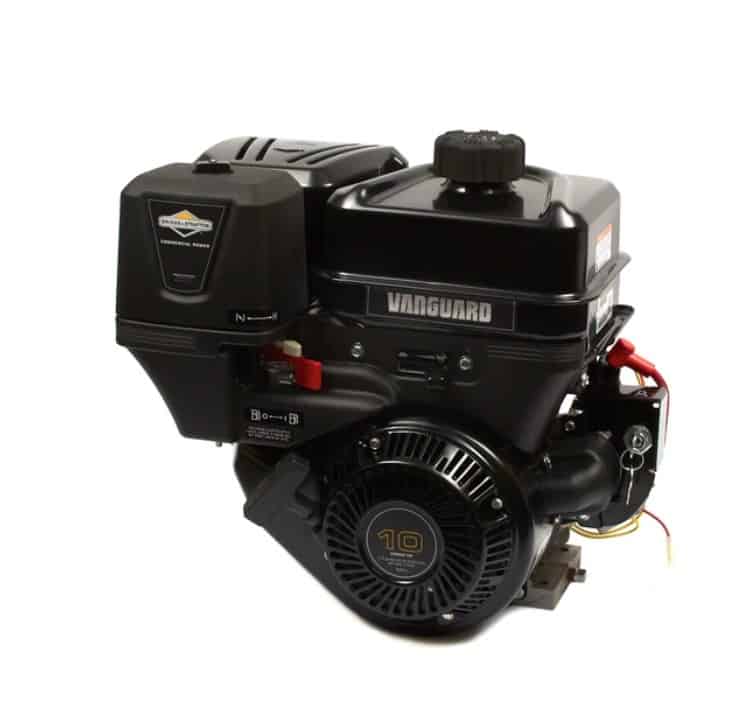Good day!
There are two main types of lawn mower engines: horizontal and vertical. Although they work for the same purposes, they come with different features that you should be aware of to take full advantage of their features.
This article will help you compare a horizontal vs. vertical lawn mower engine side by side. Both have pros and cons. So follow us to determine the proper case to use each!
Contents
Horizontal and Vertical Lawn Mower Engine
A horizontal engine is a type of internal combustion engine designed to run push-behind lawn mowers. As you can guess from the name, this unit rests in a horizontal position and has its crankshaft parallel to the ground.
Engine sizes for horizontal lawn mowers generally range from 100 CC to 190 CC, with an average horsepower rating of 4 to 7.
These engines are often air-cooled to disperse heat, having air pushed over the motor block’s fins. Their overhead valve design makes it simple for you to maintain.
A vertical engine is also an internal combustion engine. However, it primarily works for riding lawn mowers. And as the name implies, this engine rests in a vertical position with its crankshaft perpendicular to the ground.
The horse rating of this type of engine is impressive, about 10 to 25. It can be liquid-cooled or air-cooled. The larger versions often use liquid cooling systems to handle the heat.


There are two types of lawn mower engines
What Is The Difference Between A Horizontal and Vertical Lawn Mower Engine?
Horizontal and vertical lawn mower engines are different in their orientation and design, leading to other differences in their performance and maintenance requirements.
First, let’s check this comparison table to picture the distinctive features of each lawn mower engine.
| Horizontal Engine | Vertical Engine | |
| Orientation | Parallel to the ground | Perpendicular to the ground |
| Design | Shorter and wider | Narrower and taller |
| Features | Depending on the model | Depending on the model |
| Performance | 3 and 7 horsepower | 10 to 30 horsepower |
| Maintenance | Easier to maintain | Harder to maintain |
Orientation
The orientation of the engines is the most significant difference between horizontal and vertical lawn mower engines.
Vertical engines have their crankshaft perpendicular to the ground, whereas the crankshaft of horizontal engines is parallel to the ground.
Design
To handle their different orientations, vertical and horizontal lawn mower engines have different constructions.
Horizontal engines are shorter and broader than their vertical counterparts. Their carburetor and filter are on one side.
On the contrary, vertical engines are narrower and taller, with their carburetor and air filter mounted on the upper part.
Features
Both types of lawn mower engines can have pull-start or electric starters. However, most horizontal engines use the pull-start system.
Besides, the two types of engines may have liquid-cooled or air-cooled systems, with the latter being more popular.
The specific features found in each engine vary depending on the model and the manufacturer. Remember to check their specifications before you buy.
Performance
Push mowers often utilize horizontal engines with lower power outputs, usually between 3 and 7 horsepower. They are suitable for light-duty activities. Hence, you can use them for lawns in small to medium sizes.
On the other hand, riding mowers often feature vertical engines with greater power ratings from 10 to 30 horsepower. They can handle bigger lawns and rugged terrain since manufacturers build them for heavier-duty tasks.

Riding mowers with vertical engines are more powerful
Maintenance
Generally speaking, horizontal engines are simpler to maintain due to their straightforward design and accessibility.
Moreover, the carburetor and air filter are on the same side of the machine, making it easy to repair, clean, and service.
On the other hand, vertical engines are more complicated. You will find it challenging to access the carburetor and air filter on top of the engine.
Oil changes are also a crucial part of maintenance. Horizontal and vertical engines demand regular oil changes, but you don’t have the same experience.
More specifically, there is a drain plug on the bottom of the horizontal engine. Hence, you can drain the oil quickly.
However, you have to use an oil extractor to drain the oil through a dipstick tube in a vertical engine.

Horizontal engines are easier to maintain
Which Lawn Mower Is The Best For You?
Your personal requirements and tastes will eventually determine whether you choose a horizontal or a vertical lawn mower engine.
When to use the horizontal engine?
A lawn mower with a horizontal engine is the best option to mow a small to medium-sized lawn. In this case, you need lightweight, fuel-efficient, and simple-to-maintain equipment.
Horizontal engines work well for mowing on even or slightly sloping ground. Their low cost is another big plus.
When to use the vertical engine?
A lawn mower with a vertical engine will suit you better if you have a large lawn or deal with hills or uneven terrain.
Vertical engines have greater power and can do demanding mowing tasks. You can also use them in bigger riding mowers, which offer a more pleasant and efficient cutting operation.
They are a popular choice for those who want a more flexible lawn mower since they can work for pulling attachments like snow plows and trailers.

Choose the better engine based on your requirements
Frequently Asked Questions
1. Is a lawn mower engine vertical or horizontal?
We have both vertical and horizontal lawn mower engines. While some bigger riding mowers often employ a vertical engine, smaller push-style mowers work with a horizontal engine.
To determine if a particular mower has a vertical or horizontal engine, you should check the specifications of the mower you intend to buy.
2. What is the most common lawn mower engine?
Both vertical and horizontal engines are popular. For large lawns, homeowners prefer to use vertical engines. However, horizontal engines are a more common choice among houses with smaller yards.
3. What are the different kinds of lawn mowers?
There are many kinds of lawn mowers, depending on how you classify them. For example:
- Orientation: Based on the orientation, there are two types of lawn mowers, vertical and horizontal.
- Power source: A lawn mower can be electric, gasoline, or battery-powered.
- Cooling: They are air-cooling and liquid-cooling systems.
Conclusion
The decision between a vertical and horizontal lawn mower engine depends on your needs and preferences. It would be best to understand the pros and cons of each engine to settle on the better one.
Do you find this article helpful? Don’t be shy to ask for more information. Thank you for reading!





